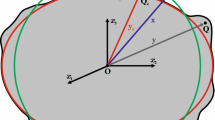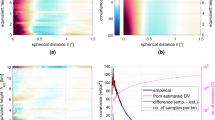Abstract
Stokes's kernel used for the evaluation of a gravimetric geoid is a function of the spherical distance between the point of interest and the dummy point in the integration. Its values thus are obtained from the positions of pairs of points on the geoid. For the integration over the near integration zone (near to the point of interest), it is advantageous to pre-form an array of kernel values where each entry corresponds to the appropriate locations of the two points, or equivalently, to the latitude and the longitude-difference between the point of interest and a dummy point. Thus, for points of interest on the same latitude, the array of the Stokes kernel values remains the same and may only be evaluated once. Also, only one half of the array need be evaluated because of its longitudinal symmetry: the near zone can be folded along the meridian of the point of interest.
Numerical tests show that computation speed improves significantly after this algorithm is implemented. For an area of 5 by 10 arc-degrees with the grid of 5 by 5 arc-minutes, the computation time reduces from half an hour to about 1 minute. To compute the geoid for the whole of Canada (20 by 60 arc-degrees, with the grid of 5 by 5 arc-minutes), it takes only about 17 minutes on a 400MHz PC computer.
Compared with the Fast Fourier Transform algorithm, this algorithm is easier to implement including the far zone contribution evaluation that can be done precisely, using the (global) spectral description of the gravity field.
Similar content being viewed by others
References
de Witte L., 1967: Truncation errors in the Stokes and Vening Meinesz formulae of different order spherical harmonic gravity terms. Geophys. J. R. astr. Soc., 12, 449–464.
Featherstone W.E., Evans J.D. and Olliver J.G., 1998: A Meissl-modified Vaníček and Kleusberg kernel to reduce the truncation error in gravimetric geoid computations. J. Geodesy, 72, 154–160.
Grafarend E. W. and Krumm F., 1996: The Stokes and Vening-Meinesz functionals in moving tangent space. J. Geodesy, 70, 696–713.
Haagmans R., de Min E. and van Gelderen M., 1993: Fast evaluation of convolution integral on the sphere using 1D-FFT and a comparison with existing methods for Stokes integral. Man. Geod., 18, 227–241.
Jekeli C., 1981: Modifying Stokes's function to reduce the error of geoid undulation computations. J. Geophys. Res., 86(B8), 6985–6990.
Martinec Z. and Grafarend E. W., 1997: Solution of the Stokes boundary-value problem on an ellipsoid of revolution. Studia geoph. et geod., 41, 103–129.
Meissl P., 1971: Preparation for the numerical evaluation of second-order Molodensky-type formulas. OSU Rep 163, Dept Geod Sci Surv, Ohio State University, Columbus.
Molodenskii M.S., Eremeev V.F. and Yurkina M.I., 1962: Methods for study of the external gravitational field and figure of the Earth. Israeli Programme for the Translation of Scientific Publications, Jerusalem.
Novák P., Vaníček P., Véronneau M., Featherstone W.E. and Holmes S.A., 1999: On the accuracy of Stokes's integration in the precise high-frequency geoid determination. AGU spring annual meeting, June 1–4, 1999, Boston, Massachusetts.
Schwarz K.P., Sideris M.G. and Forsberg R., 1990: The use of FFT techniques in physical geodesy. Geophys. J. Int., 100, 485–514.
She B.B., 1993: A PC-based unified geoid for Canada. UCGE Reports #20051, Department of Geomatics Engineering, The University of Calgary, Calgary, Alberta.
Sjöberg L.E., 1984: Least-squares modification of Stokes's and Vening Meinesz's formula by accounting for truncation and potential coefficient errors. Man. Geod., 9, 209–229.
Sjöberg L.E., 1986: Comparison of some methods of modifying Stokes's formula. Boll. Geod. Sci. Aff., 45, 229–248.
Sjöberg L.E., 1991: Refined least-squares modification of Stokes's formula. Man. Geod., 16, 367–375.
Stokes G.G., 1849: On the variation of gravity on the surface the Earth. Trans. Cambridge Phil. Soc., 8, 674–695.
Strang van Hees G., 1990: Stokes formula using Fast Fourier Techniques. Man. Geod., 15, 235–239.
Vaníček P. and Krakiwsky E., 1986: Geodesy: The Concepts, 2nd edition, Elsevier.
Vaníček P. and Kleusberg A., 1987: The Canadian Geoid — Stokesian approach. Man. Geod., 12, 86–98.
Vaníček P. and Sjöberg L.E., 1991: Reformulation of Stokes's theory for higher than second-degree reference field and modification of integration kernels. J. Geophys. Res., 96(B4), 6529–6539.
Vaníček P. and Featherstone W.E. 1998: Performance of three types of Stokes's kernel in the combined solution for the geoid. J. Geodesy, 72, 684–697.
Wong L. and Gore R., 1969: Accuracy of geoid heights from modified Stokes kernels. Geophys. J. R. astr. Soc., 18, 81–91.
Author information
Authors and Affiliations
Rights and permissions
About this article
Cite this article
Huang, J., Vaníček, P. & Novák, P. An Alternative Algorithm to FFT for the Numerical Evaluation of Stokes's Integral. Studia Geophysica et Geodaetica 44, 374–380 (2000). https://doi.org/10.1023/A:1022160504156
Published:
Issue Date:
DOI: https://doi.org/10.1023/A:1022160504156




